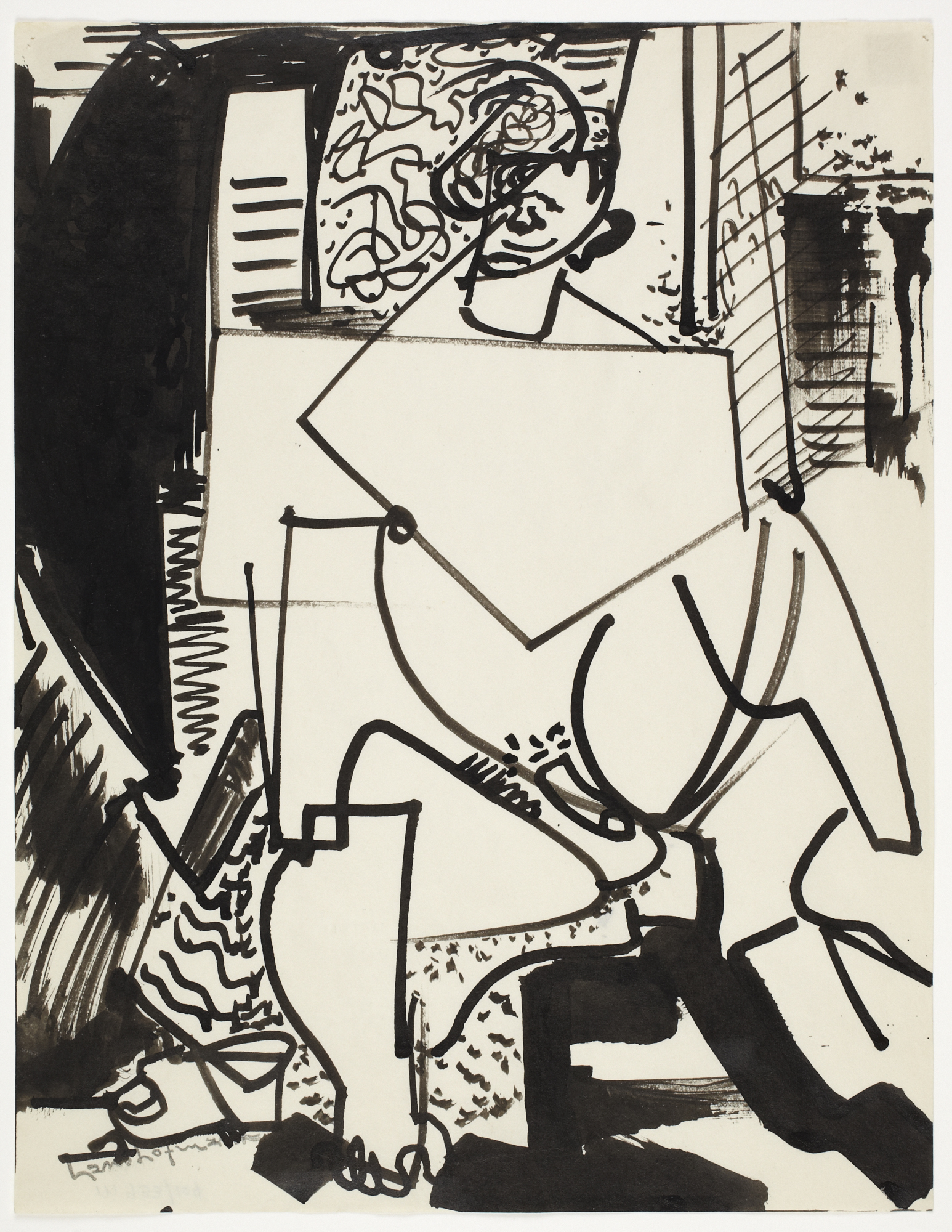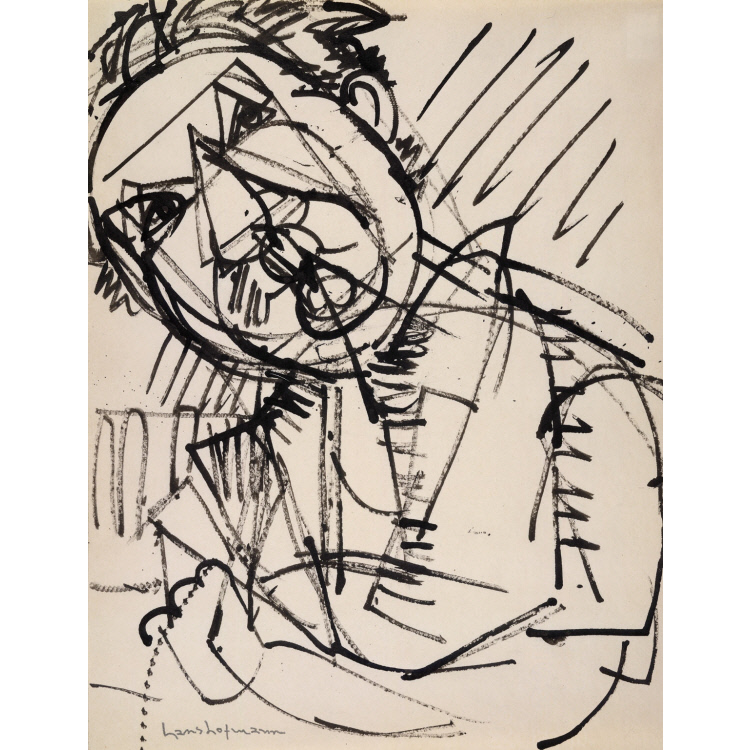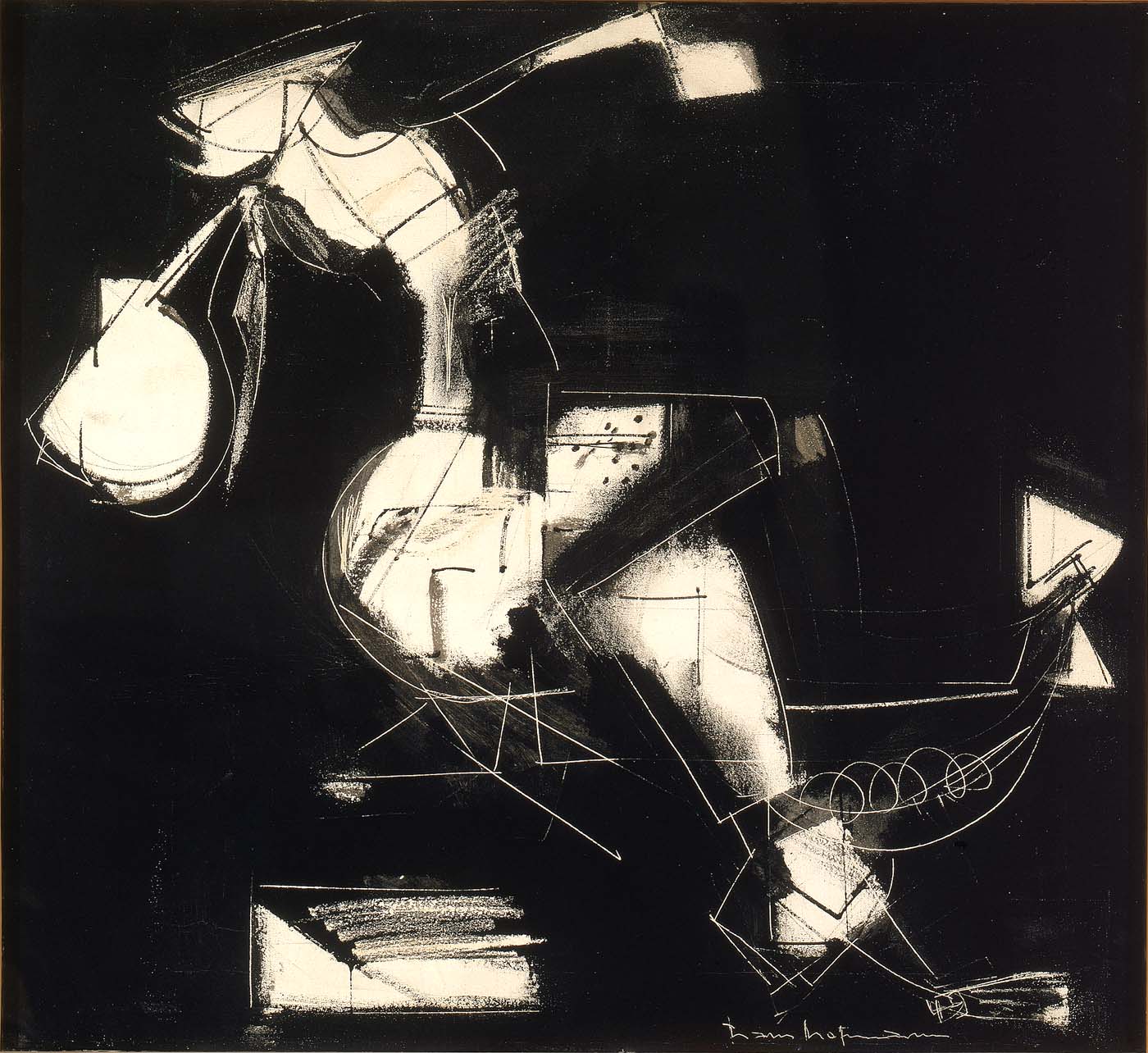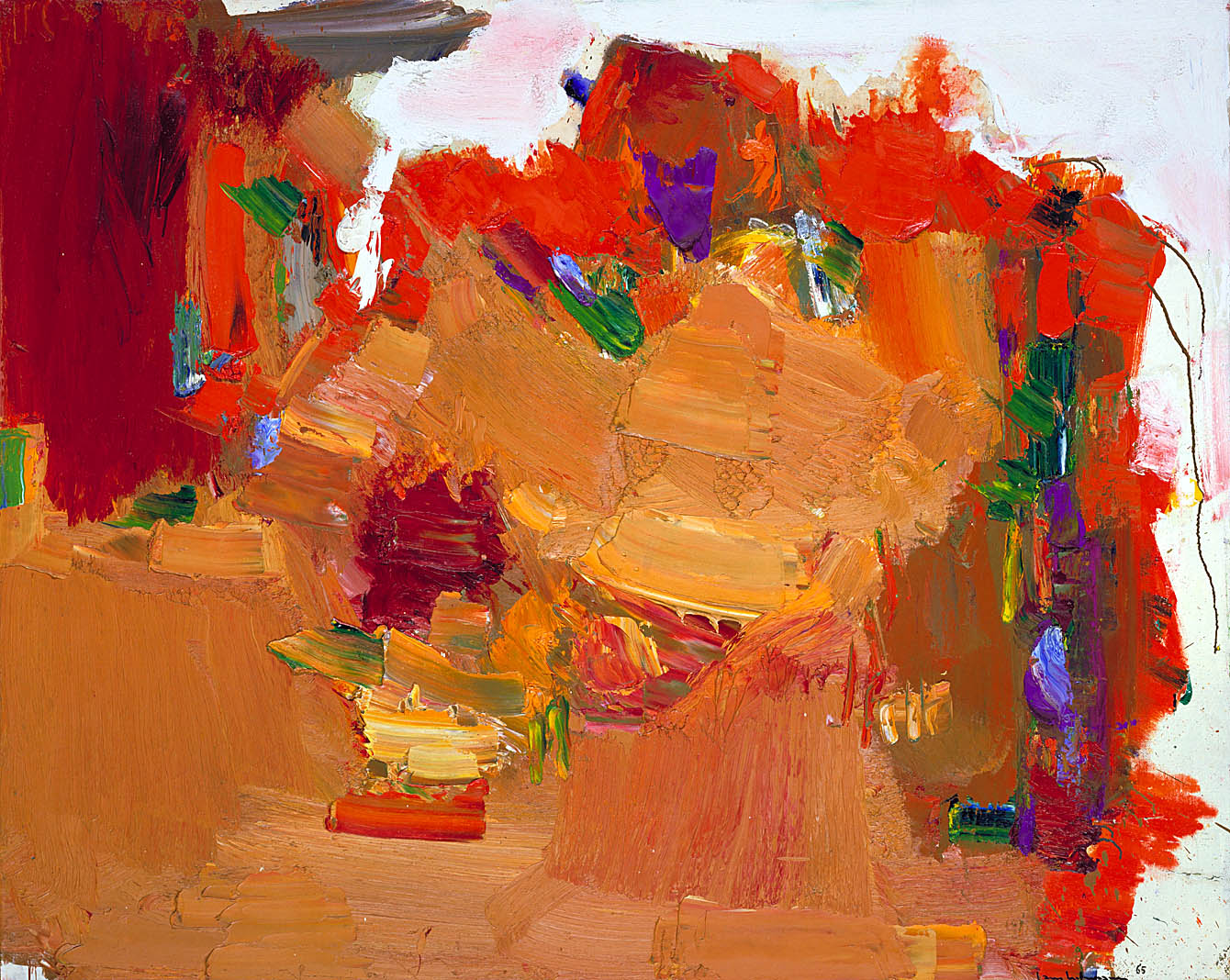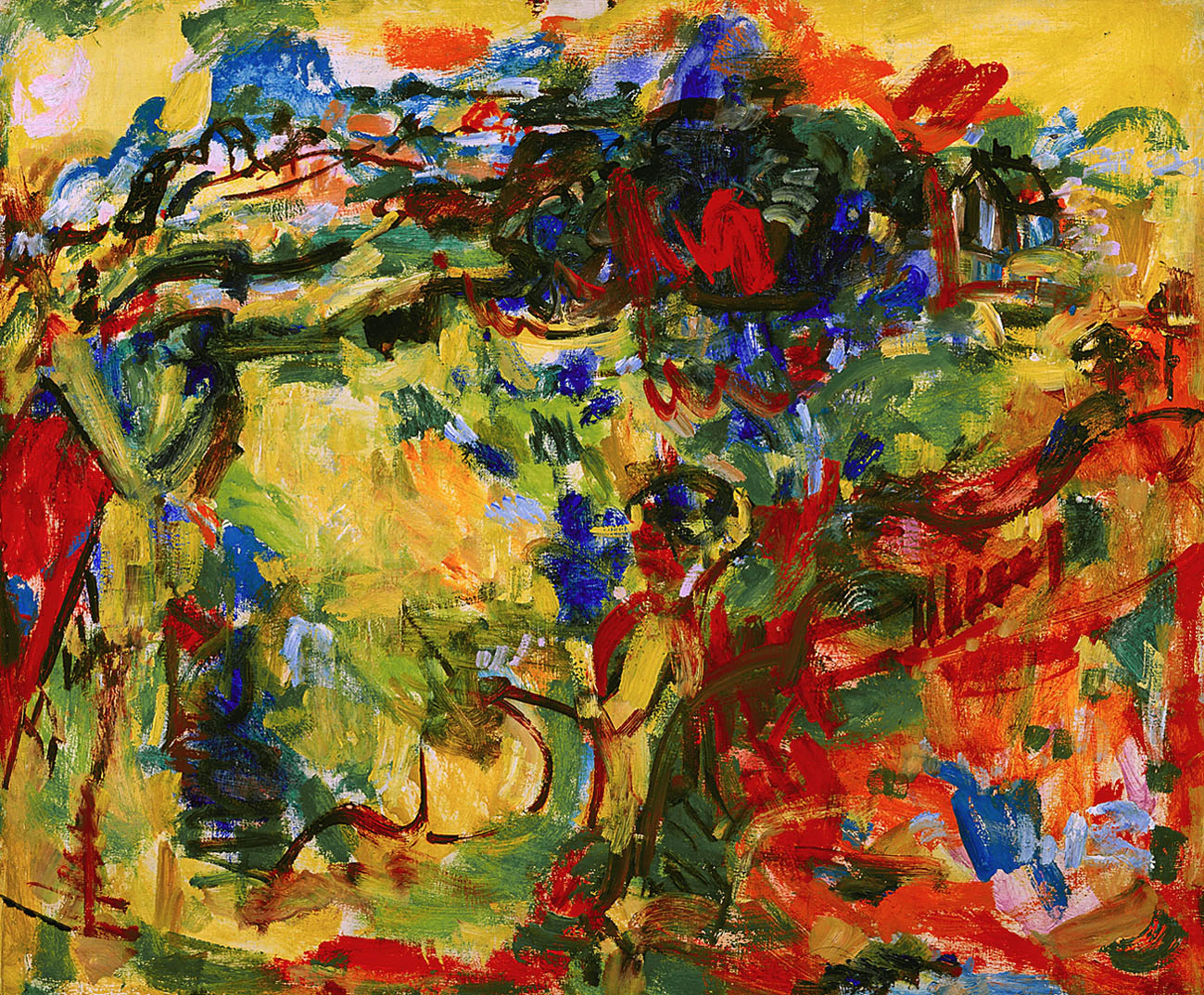Hans Hofmann
In 1966, a month before his death, Hans Hofmann described his process of painting in these words: "When I paint, I paint under the dictate of feeling or sensing, and the outcome all the time is supposed to say something. And that is most often my sense of nature. . . it might suggest landscape and might only suggest certain moods, and so on but this must be expressed in pictorial means, according to the inner laws of these means. Only this is acceptable as art."(1)
Hofmann was both an intuitive painter and a man with a profound understanding of modernism. He insisted on the importance of an analytical understanding of the means of painting. His ideas on art developed initially during his years in Paris. From 1904 to 1914, he knew Matisse, Picasso, Braque, and Delaunay. He frequented the Café du Dôme, where artists congregated to discuss not only ideas about art, but new theories of the universe, from Einstein's theory of relativity to Bergson's notion that movement and constant change are basic characteristics of reality.(2)
Hofmann grew up in Munich. As a gymnasium student, he excelled in music, science, and mathematics. At sixteen, as an assistant to the director of public works in Bavaria, his engineering skills became apparent. He invented a radar device for ships, a sensitized light bulb, and a portable freezer unit for use by military forces.(3) With a thousand marks as a gift from his proud father, Hofmann enrolled in art school. Soon he had encountered Impressionism, and discovered the Secession Gallery in Munich. The support of a patron allowed him to go to Paris. He attended evening classes at the Colarossi Academy and at the Académie de la Grande Chaumière. Hofmann became close friends with Jules Pascin and Robert Delaunay, whose theories on color seeded Hofmann's own ideas about color and form. At this time, Hofmann was painting Cubist still lifes, landscapes, and figurative pieces, and his work was included in group exhibitions at the New Secession Gallery in 1908 and 1909.
Hofmann went home for a visit in 1914. When World War I prevented his return to Paris, he opened his school for modern art in a Munich suburb. During the war years, Hofmann became closely acquainted with Kandinsky's work.(4) Following the war, young Americans began to flock to Hofmann's school. Carl Holty, Worth Ryder, Glenn Wessels, Vaclav Vytlacil, and others studied in Munich or attended his summer classes in Bavaria, France, and Italy.(5) In the summer of 1930, at the invitation of Worth Ryder, Hofmann taught at the University of California, Berkeley. He spent the next winter in Germany, and the following spring returned to teach in Los Angeles (at the Chouinard School of Art) and at Berkeley, where he wrote the first version of Creation in Form and Color: A Textbook for Instruction in Art. In 1932, he moved to New York. He taught for a year at the Art Students League, where his students included Burgoyne Diller, Harry Holtzman, and George McNeil. The following year he opened his New York school, and in the summer of 1935 began annual summer sessions in Provincetown, Massachusetts. In 1958, at age seventy eight, Hofmann finally gave up teaching to concentrate full time on painting.
It would be virtually impossible to overestimate Hofmann's importance as a teacher. Over half the original members of the American Abstract Artists were Hofmann students. Many second generation Abstract Expressionists worked with him as well. He provided scholarships to those unable to payfull tuition, and frequently allowed students to work for him in exchange for instruction. Whether or not they attended his classes, many artists knew of Hofmann's ideas. An essay entitled "Plastic Creation" was published in the Art Students Leaguemagazine during the winter of 193233, and a series of six lectures given during the winter of 193839 was attended by Jackson Pollock, Arshile Gorky, Willem de Kooning, Clement Greenberg, and HaroldRosenberg.(6)
In his teaching, as in his art, Hofmann advocated nature as a starting point. He had students draw from life and from carefully arranged still life set ups to learn the importance of formal and spatial relationships. Although he promoted no style (many of his students were for years vague about Hofmann's own art), manyunderstood not only modernism, but Renaissance and Baroque art for the first time through Hofmann's explanations.(7) He considered drawing a critical precursor to painting, yet his emphasis on color, rather than perspective, as a determiner of space within a picture plane, lay at the heart of his ideas about art. For Hofmann, the artist worked to express the tension between three dimensional form and the two dimensional surface of the canvas. Yet in his own painting, he himself denied theory and method, and relied only on empathy.(8) Hofmann defined empathy as "the imaginative projection of one's own consciousness into another being or thing. In visual experience, it is the intuitive faculty to sense qualities of formal and spatial relations or tensions, and to discover the plastic and psychological quality of form and color."(9)
Hofmann's career as a teacher for many years disrupted his own work as an artist. From 1927 until 1935, he concentrated primarily on drawingslandscapes and figure sketches that reflected his early familiarity with Cubism. He began painting seriously again in 1935, and during the following decade landscapes, portraits, still lifes, and interior scenes were translated into highly expressionistic, energetic canvases. During the summers, especially, when Hofmann held sessions in Provincetown, he returned to landscapes such as Afterglow (1938). Subsequently, Hofmann began to pour and splatter paint, and increasingly exploited the accidental in his search for spontaneous expression.
Despite his renown as a teacher, it wasn't until 1944, at Peggy Guggenheim's Art of This Century Gallery, that Hofmann had his first solo exhibition in the United States. There he became part of the emerging New York School, and was friendly with Pollock, Robert Motherwell, William Baziotes, Clyfford Still, and Mark Rothko. From that time on, Hofmann exhibited widely. The Addison Gallery of American Art organized a large retrospective of his work in 1948. In 1957 another was mounted at the Whitney Museum of American Art.
Although Hans Hofmann never joined the American Abstract Artists, he encouraged its membership and sent a letter of support when the organization was formally established. Yet, through his students, who represented not only a significant number of the membership, but an important counterbalance to the geometric formalists, Hofmann's influence within the group was remarkable.
1. Irma B. Jaffe, "A Conversation with Hans Hofmann," Artforum 9, no. 5 (January 1971): 35.
2. For an in depth discussion of Hofmann's Paris years, see Ellen G. Landau, "The French Sources for Hans Hofmann's Ideas on the Dynamics of Color Created Space," Arts Magazine 51, no. 2 (October 1976): 76–81.
3. An excellent chronology of Hofmann's life can be found in Cynthia Goodman, Hans Hofmann (New York: Abbeville Press, 1986), pp.117–19.
4. According to Carl Holty, when Kandinsky went to Russia in 1914 and due to the war was unable to return to Munich, Hofmann had charge of the paintings Kandinsky had left behind; interview with Nina Wayne, Archives of American Art, Smithsonian Institution, Washington, D.C., roll 670.
5. Cynthia Goodman, in "Hans Hofmann As a Teacher," Arts Magazine 53, no. 8 (April 1979): 120, writes "Among earliest memories of the Munich school are those of Vaclav Vytlacil. When he and Ernest Thurn enrolled, either late autumn 1921 or early spring 1922, the classes were held in a small dingy and poverty ridden single studio
[in a] rather dismal building.
Glenn Wessels. . .
tutored Hofmann in English every day before class in exchange for tuition."
6. Typescripts of these lectures can be found in the Karl Knaths Papers, Archives of American Art, roll 433: 1317–1465.
7. Hofmann often illustrated his lectures with diagrams of the compositional structure and movement in paintings by Piero della Francesca, Giotto, and Rembrandt, as well as Cézanne, Picasso, Braque, and other moderns.
8. Cynthia Goodman, in "Hans Hofmann As a Teacher," Arts Magazine 53, no. 8 (April 1979): p. 113.
9. Quoted in Dorothy Seckler, "Can Painting Be Taught?," Art News 50, no. 1 (March 1951): 63. The writings of Wilhelm Worringer, a German philosopher and psychologist, became meaningful for artists during the early years of the twentieth century.
Virginia M. Mecklenburg The Patricia and Phillip Frost Collection: American Abstraction 1930–1945 (Washington, D.C.: Smithsonian Institution Press for the National Museum of American Art, 1989)
Objects at The Amon Carter (1)
Objects at Princeton University Art Museum (1)
Objects at National Portrait Gallery (1)
Objects at Indianapolis Museum of Art at Newfields (2)
Objects at Smithsonian American Art Museum (3)
Objects at Archives of American Art (22)


